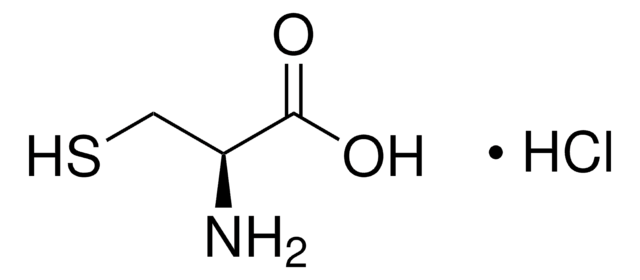1.02839
L-cystéine hydrochloride monohydrate
for biochemistry
Synonyme(s) :
Cys, L-Cysteinium Chloride Monohydrate, L-Cysteine Hydrochloride, Monohydrate
About This Item
Produits recommandés
Pression de vapeur
<0.1 hPa ( 20 °C)
Niveau de qualité
Essai
98.5-101.0% dry basis (alkalimetric)
Forme
crystalline powder
pH
0.8-1.2 (20 °C, 100 g/L in H2O)
Pf
168-170 °C
Solubilité
650 g/L
Densité
1.54 g/cm3
Masse volumique apparente
780 kg/m3
Traces d'anions
sulfate (SO42-): ≤300 ppm
Traces de cations
Fe: ≤20 ppm
heavy metals (as Pb): ≤10 ppm
Température de stockage
2-30°C
Chaîne SMILES
O.Cl.N[C@@H](CS)C(O)=O
InChI
1S/C3H7NO2S.ClH.H2O/c4-2(1-7)3(5)6;;/h2,7H,1,4H2,(H,5,6);1H;1H2/t2-;;/m0../s1
Clé InChI
QIJRTFXNRTXDIP-JIZZDEOASA-N
Vous recherchez des produits similaires ? Visite Guide de comparaison des produits
Catégories apparentées
Application
- Smartphone-based Ellman′s colourimetric methods for the analysis of d-penicillamine formulation and thiolated polymer: Demonstrates the application of L-Cysteine hydrochloride monohydrate in developing colorimetric assays for pharmaceutical analysis, enhancing the accessibility and cost-effectiveness of drug quality control (Phadungcharoen et al., 2019).
- The effects of the thiolation with thioglycolic acid and l-cysteine on the mucoadhesion properties of the starch-graft-poly(acrylic acid): Focuses on the modification of polymers with L-Cysteine hydrochloride monohydrate to improve their mucoadhesive properties, which is critical for developing more effective drug delivery systems (Gök et al., 2017).
- On-line pre-reduction of pentavalent arsenicals by thioglycolic acid for speciation analysis by selective hydride generation-cryotrapping-atomic absorption spectrometry: Utilizes L-Cysteine hydrochloride monohydrate in analytical chemistry techniques to improve the detection and measurement of toxic elements in environmental samples, crucial for monitoring and ensuring public health (Musil et al., 2008).
Actions biochimiques/physiologiques
Remarque sur l'analyse
Identity (IR-spectrum): passes test
Identity (Chloride): passes test
Appearance: white or almost white, crystalline powder or colorless crystals
Appearance of solution (25 g/l, water): clear and not more intense in color than reference solution BY6
Spec. rotation (α 20/D, 80 g/l, hydrochloric acid 250 g/l, calc. on dried substance): +5.5 to +7.0
Spec. rotation (α 25/D, 80 g/l, hydrochloric acid 6 mol/l, calc. on dried substance): +5.7 to +6.8
Sulfate (SO₄): ≤ 300 ppm
Heavy metals (as Pb): ≤ 10 ppm
Fe (Iron): ≤ 20 ppm
Related Compounds, total (TLC): ≤ 0.5 %
Ninhydrin-positive substances (LC)(impurity A (570 nm)): ≤ 0.5 %
Ninhydrin-positive substances (LC)(any ninhydrin-positive impurity): ≤ 0.2 %
Ninhydrin-positive substances (LC) (ammonium (570 nm)): ≤ 0.02 %
Ninhydrin-positive substances (LC)(total impurities): ≤ 1.0 %
Residual solvents (ICH Q3C): excluded by manufacturing process
Sulfated ash (600 °C): ≤ 0.1 %
Loss on drying (Vacuum < 0.7 kPa, P₂O₅, 24 h): 8.0 - 12.0 %
Bacterial endotoxins: ≤ 6.0 I.U./g
Code de la classe de stockage
11 - Combustible Solids
Classe de danger pour l'eau (WGK)
WGK 1
Point d'éclair (°F)
Not applicable
Point d'éclair (°C)
Not applicable
Certificats d'analyse (COA)
Recherchez un Certificats d'analyse (COA) en saisissant le numéro de lot du produit. Les numéros de lot figurent sur l'étiquette du produit après les mots "Lot" ou "Batch".
Déjà en possession de ce produit ?
Retrouvez la documentation relative aux produits que vous avez récemment achetés dans la Bibliothèque de documents.
Les clients ont également consulté
Notre équipe de scientifiques dispose d'une expérience dans tous les secteurs de la recherche, notamment en sciences de la vie, science des matériaux, synthèse chimique, chromatographie, analyse et dans de nombreux autres domaines..
Contacter notre Service technique


